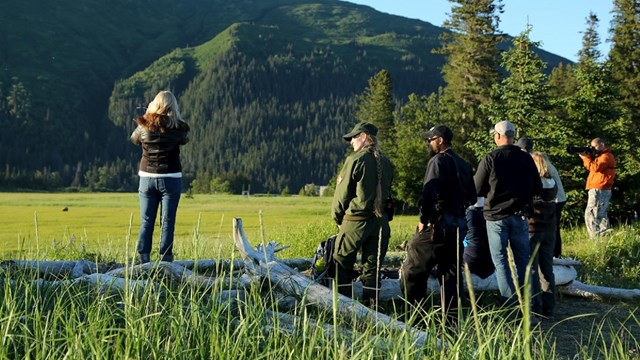Last updated: December 9, 2020
Article
West Cook Inlet Coastal Archeology

NPS Photo/A. Jones

John Thwaites, mail clerk on the S.S. Dora/The Anchorage Museum of History and Art; B82-52-225.
The Land Shapes The Tools
The Dena’ina are Athabaskan-speaking native people who live in Southcentral Alaska. They are deeply connected to the region, and according to oral traditions and archeological evidence began occupying the Cook Inlet area a thousand or more years ago. As inland groups transitioned to coastal areas, they began to incorporate maritime practices into their traditional terrestrial and riverine lifestyle. This reshaped their hunting and fishing strategies and techniques. Several technologies developed by the Alutiiq, such as the kayak, umiak (open boat made of hide stretched over a wooden frame), and harpoon, found their way into Dena’ina culture. Spearing platforms, or spearing trees, placed on tidal flats, began to appear in their subsistence strategy, which aided in beluga whale hunting. The technique was likely derived from their use of game platforms along rivers placed to assist in bear hunting.

NPS Photo
Arctic Small Tool Tradition
A brief occupation appeared along the coast between 1800-1600 BC. Archeological materials supporting this occupation include stone tools, hearths with burned debris and sediment, fire-cracked stones, and fish bone remains. A small bifacially flaked point from the site morphologically resembles endpoints from the Arctic Small Tool tradition. The tradition is known for using small projectile points, and likely moved southward from Bering Strait to the Alaska Peninsula. It is still unclear how the Arctic Small Tool tradition came to Cook Inlet, but a plausible theory suggests movement up from the Alaska Peninsula or Bristol Bay. With active volcanoes, such as Redoubt, in the vicinity as well as the presence of tephra deposits at the site, the influence of volcanism on communities cannot be ruled out for the end of the occupation.A Conceptualized Landscape
Subsistence practices throughout the region took on a variety of forms that have shifted and changed over time in the course of various traditions and occupations. Despite changes in the environment and human patterns, the use of marine resources has remained a common factor. Fish, sea mammals, waterfowl, and shellfish are all invaluable resources that supply coastal communities with everyday needs.
Unearth how archeologists study the past, solve mysteries, and uncover the stories buried throughout our history.

A trip to Silver Salmon Creek on Lake Clark's Cook Inlet coast offers outstanding bear viewing and sport fishing opportunities for visitors.

A trip to Chinitna Bay on Lake Clark's Cook Inlet coast offers a unique experience in the heart of coastal brown bear country.
